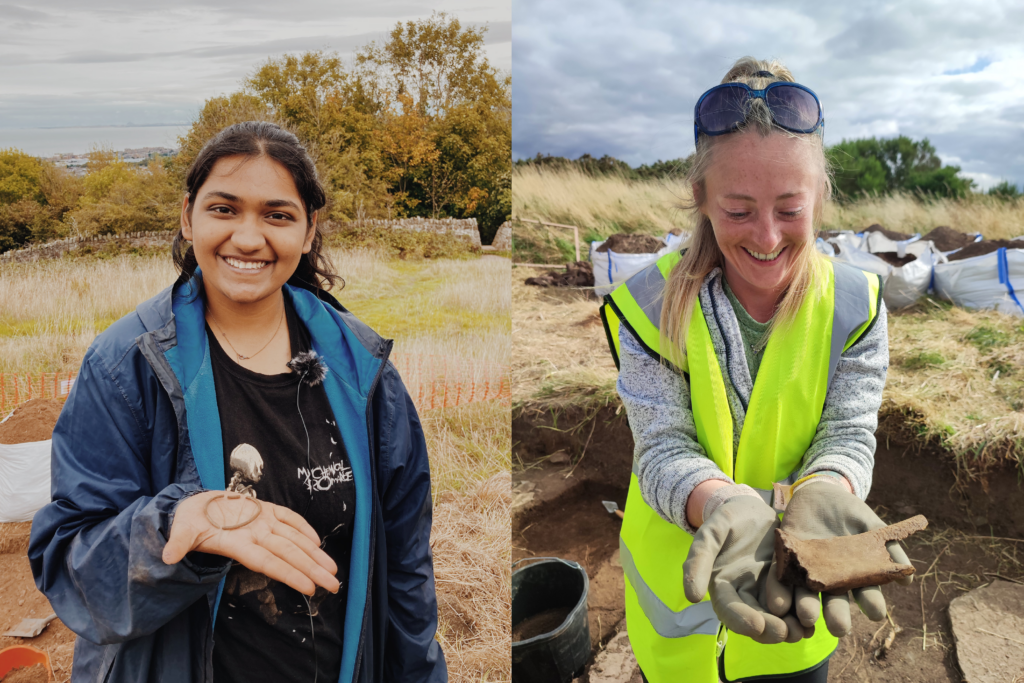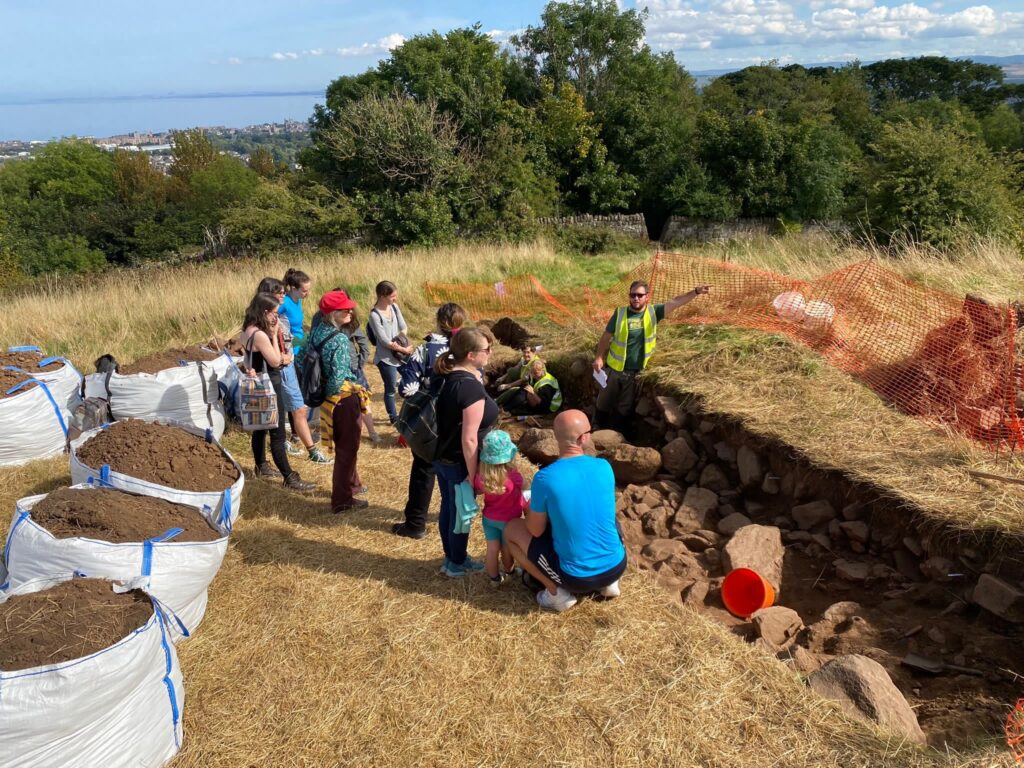Edinburgh alumna and current PhD student in Archaeology, Emily Johnston, tells us why archaeology rocks, what’s hiding beneath Holyrood Park, and why she loves to shout about it all.
Current treasured object: A necklace that my grandma gave to me which has the Scottish rampant lion on it – I wear it most days!
Song of the moment: ‘I’m in the Mood for Dancing’ – The Nolans. I recently rediscovered this song and can’t stop listening to it when I need a bit of motivation. It’s the perfect song to get moving to!
The first thing I noticed when I woke up this morning: The sound of the builders on the street who start work early and wake me up!
———————————————————
I decided I wanted to be an archaeologist when I was seven. My primary school class was studying the topic of ‘the Celts’ and we took a trip to Aberdeen’s Marischal Museum. We got to meet a curator who showed us artefacts and told us their stories. I remember at that point becoming infatuated with the world of archaeology and completely in awe of the objects that she was showing us. My mum enrolled me in the Aberdeen Young Archaeologists Club, and I remember receiving books on archaeological discoveries for Christmas. I continued with this passion throughout my secondary school, and took any history or ancient world related subject available. In my fifth year, I undertook a work experience week at the same Marischal Museum, and got to see behind the scenes of the museum, which was fascinating.
I’ve always loved to tell stories about the past and found during my undergraduate that I would lean towards opportunities to share the past with different audiences.
During my undergraduate studies at the University of Edinburgh, I developed a blog through which I shared stories about the places I visited and their history. Through this I first came across Dig It! – a project coordinated by the Society of Antiquaries of Scotland that aims to increase engagement with archaeology for Scotland-based audiences. Dig It!’s ‘Scotland’s Digs’ campaign is fantastic and showcases a huge range of activities across Scotland each summer, including open days, site tours, evening lectures, as well as chances to take part in surveys, field walking and excavations! I got involved in their 2015 and 2017 campaigns, and I became really interested in digital outreach. This developed my passion for sharing archaeology with the public, and I began to take on roles that allowed me to do so.
I’m currently a third year PhD student in Archaeology at the University of Edinburgh. My research looks at community engagement in Scottish developer-led archaeology – this is archaeology undertaken to offset the impact that development, such as the building of new houses, has on our historic environment. Before returning to Edinburgh for my PhD, I worked in commercial archaeology across the UK (commercial archaeologists are involved in recording and excavations pre-construction). Some of the sites I worked on, such as the Edinburgh Tram Extension, received a lot of public interest, due to the archaeology and the positioning of the site, and I really enjoyed any opportunity to engage with passers-by. Through my experience in commercial archaeology, I noticed a lack of opportunities for engagement with the public and began to question the causes of this and how this could be improved. This spurred me on to develop a research proposal looking at how we can implement greater engagement in the development funded sector. This is a topic that has not been researched in great depth previously.
Alongside my PhD research, I’m also involved in a variety of activities. I am the Outreach Officer for the Holyrood Archaeology project, a collaboration between the University of Edinburgh, Historic Environment Scotland and AOC Archaeology, led by Professor Jon Henderson, Dr Graeme Cavers and Richard Strachan. The project began in 2021 to investigate the archaeology of Holyrood Park.

Holyrood Park has over 100 archaeological sites, many of which are unknown to the public. These date from the Mesolithic to more recent history such as the Second World War, and span a huge range of activities. For example, the park has been settled throughout prehistory – within the park, there are at least four Iron Age hillforts, which can help to tell us about networks and connections in the Iron Age. During the Second World War, Holyrood Park was used as training grounds, and practice trenches and defensives can be found. For the past two years we have been excavating Dunsapie Hillfort, and it has been exciting to uncover the ramparts of the fort, and traces of life in the Iron Age.
Very little of the park has been excavated previously, and the Holyrood Archaeology project is the first recent project to do so.
The most striking feature to have been excavated during the Holyrood Archaeology project is the ramparts themselves. These are thick stone walls, and we have been able to identify phasing of the walls. A real highlight was the discovery of Iron Age pottery right at the surface of the rampart – we were surprised it had even survived, as Iron Age pottery does not often survive, let alone in the shallow deposit where it was found. A shallow hollow in the bedrock seems to have provided protection to it. An exciting find (typically, right at the end of the season), was a copper-alloy bangle. These kinds of finds help to provide a tangible link to those who were living at the site, which is one of my favourite aspects of digging.

The park is visited daily by hundreds of visitors, including locals and tourists, most of whom visit to summit Arthur’s Seat. The impact of the footfall on the archaeology across Holyrood Park is unknown, and therefore, we are at risk losing some of these sites. Each season, the Holyrood Archaeology project results are fed back to Historic Environment Scotland to help them with the conservation and management of the park. The project also provides training to University of Edinburgh students and was developed alongside AOC Archaeology in order to teach the students archaeological skills that will equip them for a career in archaeology.
I find archaeological outreach to be a rewarding and fun profession, which suits my personality as I enjoy talking and meeting new people!
As Outreach Officer, I have developed an outreach plan for the Holyrood Archaeology project, in collaboration with AOC. Day-to-day, I take photographs and videos of the students at work and share live updates from the site to our social media channels. I have also created a series of longer form videos from the 2022 season for YouTube. I oversee our site blog and manage daily posts from students working the trenches. Last season, I organised local Edinburgh primary school visits, and led sessions with seven classes. These visits were a lot of fun to deliver, as the pupils had lots of interesting thoughts and questions, and I was able to involve a lot of the team. I also provided small group tours and helped to organise two open days for the public, leading tours across the site and sharing our season finds.

Those who came along to our open days really enjoyed themselves – we predominantly had locals visit, and many of them didn’t know the history of Dunsapie. A lot of locals, like dog walkers, prefer to climb Dunsapie rather than Arthur’s Seat, so regularly visit the site, but had no idea there was a hillfort under their feet. During the open days, they were able to see the excavations as they progressed, and many enjoyed talking to the students and asking them questions. We also had a finds handling kit and some of our season finds on show, and the public were excited at the opportunity to handle some of them themselves!
I believe that community engagement is important because we share history – it doesn’t belong to the archaeologist excavating it, and you don’t have to have an archaeological background to value or feel attached to it.
Archaeological remains are tangible connections to the past, which contribute to our sense of heritage and sense of belonging. Everybody has a right to access the past, and as archaeologists we are responsible for helping to uncover and share those stories, and we should be looking towards new, diverse and accessible ways for the public to experience it with us. Community engagement then provides a springboard for discussions on heritage crime, heritage management, and archaeology’s place in policy and legislation. I believe that our shared past lies central to archaeology, and at the core of community engagement.
Links and sources:
The Holyrood Archaeology project
© Banner photograph: Emily Johnston photographed at Dunsapie Hillfort; courtesy of Emily Johnston



